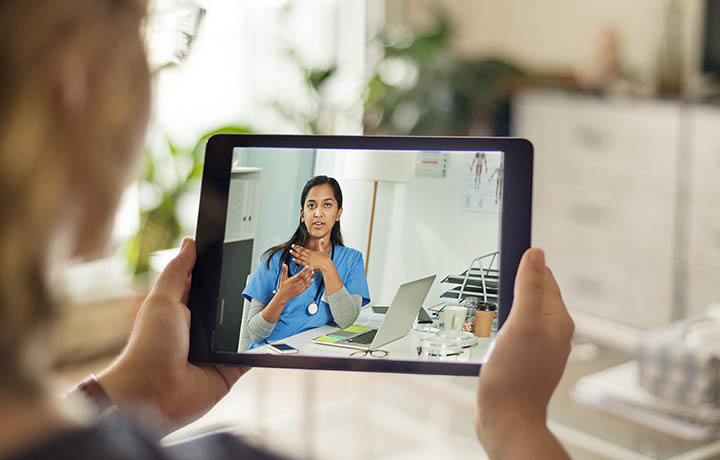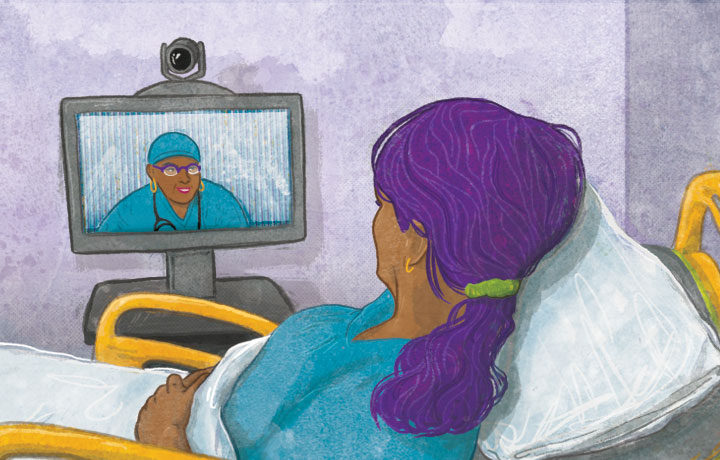Article
Virtual medicine’s place in the care continuum
By Joanna Weiss | August 23, 2016

athenaInsight spoke with Gutman about the impact virtual medicine, including telemedicine, is having on strategies to deliver care.
Virtual care is here to stay. It creates an experience in healthcare just like what's happening in commerce. We buy something at a store, in the real world, and then have a phone or online or text interaction afterward. Right? Or we find something online and then go into the real world to buy it.
Amazon is a great example of bridging virtual experiences with fulfillment and logistics and all those things that happen in the real world. And it will start happening in how we experience healthcare, too: part of care will be transmitted virtually and part of it will happen in the real world, and it will go back and forth. Every hospital will have a strategy for how they incorporate virtual care into what they are doing.
It's in transition. Every new technology has an adoption curve. That's normal. The more people start doing it and experiencing the benefit of doing it, the more they will do it. We're seeing that happen now in telemedicine. The first time, people are reluctant. Even people who are pretty techie still have a habit of saying, “I need a doctor, I'll call to schedule an appointment." It takes time for people to try virtual care, experience it, get the benefit, and start making it part of how they live their lives. We can help accelerate the process by creating a delightful experience.
Context matters. And relationships matter. The problem with telemedicine is that when people need care, they forget about it. They're stressed, so they resort to doing what they're accustomed to doing. When people go to their doctor's office, they're coming to solve a problem. So there's an opportunity to make the transition in that context because they trust the doctor. They need a solution and have someone trustworthy who tells them, “Here's a better solution." It's a magical moment.
Virtual care connects it all. It's a layer that brings together all the external and internal sources of patient engagement. It takes these fragmented and distributed experiences, each of which generates some data, to bring it into one place. Then we can start doing meaningful things with the data to help doctors, patients and institutions make better decisions. Bringing it all together makes the entire system smarter. This is the key.
Over the past six years, we've spent a tremendous amount of time learning how to engage doctors and patients. We have answers to questions. We have tips, news, reviews, consultations, reminders. I can go on and on. And each of these pieces increases engagement on the consumer side.
The same thing happens on the doctors' side: we have 27 different value propositions for doctors so far. So, we own the interfaces that create engagement on these two sides and then we connect the dots. We don't own the data. The patient owns the data. We bring the data to a point where the patient can manage it — and do a lot with it.
With the permission of the patient, of course. Today, the provider has access to the data, but the patient doesn't.
It's like your phone. Apple wants location-based data so it asks “Would you like to share your location?" again and again because it's private data. And, most of the time, you say yes. So they use your data, but with your permission. It's a very patient-centric approach, and very smart.
This is the beautiful thing. Hospitals can get data they've never had before. They've never had browsing data. Or telemedicine or engagement data. But we can collect this in our system, and they can get the data from there with permission from the user. The hospitals can now have tracking data for their patients.
There was a great class at Stanford that was called “incentives and productivity." In the first class, the professor said, “I'll tell you one thing and then you can skip the rest of the class because if you understand this one thing, you understand everything about incentive and productivity." Then he said: “People will do what you incentivize them to do." Fee-for-service incentivizes providers to push more services so they make more money.
The telemedicine industry is fee-for-service: $50 bucks per consult. So what happens in a boardroom of a telemedicine company that wants to grow really fast? The board says, “sell more consults." But people don't need more consults. So we need to get out of this system. However, there's a catch-22: Doctors are saying “You want to make me accountable for the care of people. Now you're telling me that not only am I responsible when they come into my office but I also have to deal with stuff outside of the visit. But I don't have any tools to do that. How can I take responsibility?"
I was one of Uber's first users. I love what they're doing because it's a delightful experience. They took a really bad experience and used technology – and you don't usually think about technology when you think about car rides – and created a delightful experience. I love Amazon because I like things that make my life better. They're both great examples of taking something mundane, or even convoluted and difficult, that you do daily and streamlining it. Making it delightful. I want healthcare to be the same because nobody wants to dwell on healthcare. It's not a social network. It's not a game. You don't want to spend more time dealing with your health than you need to. Give me a good experience and get it done. I think it's possible.
Everyone thinks let's put a doctor on Skype and we'll be doing virtual care. That's the furthest thing from reality that you can imagine. Not everything can be done in virtual care. Our [continuing medical education] course has a clinical module dealing with what's appropriate and inappropriate for virtual care.
There are also practical issues. Young doctors, for example, are really excited about delivering virtual care from their phones. They can actually do a video consult on their phone, with full documentation, which is pretty cool. So now they're somewhere away from their office, and they do five or six consultations back to back. Then their battery dies. In the real world, you just have patients. You see them one after the other. Who needs to worry about charging a phone? It's not a small thing because the patient needs their doctor and suddenly the screen goes black and the patient doesn't even know what happened. The doctor's not there.
Virtual medicine is still medicine, but it's a different medium with its own requirements.






